Glorious hours of May
by Henry Jayasena
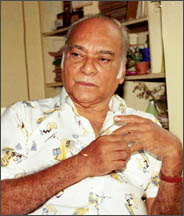 Vesak is a lot of hallowed things for lots of people. For Buddhist
monks and followers of the Buddha's Way of Life all over the world it is
a time of deep commitment, veneration, gratitude and acts of dedication,
preachings of the Noble Truth and self assessment. Vesak is a lot of hallowed things for lots of people. For Buddhist
monks and followers of the Buddha's Way of Life all over the world it is
a time of deep commitment, veneration, gratitude and acts of dedication,
preachings of the Noble Truth and self assessment.
For lay people it is a time of deeply rooted religious observation,
observing the eight or ten higher precepts, Dana, Seela, Bhavana,
tending the sick and those in need and being far better in the
observation of the RIGHT path of life.
For young parents, elder brothers, sisters, uncles and aunts, it is a
time of helping their sons and daughters, brothers and sisters, nieces
and nephews, to make that all important Vesak Kooduwa, Sal Uyana,
Abhinishkramanaya, Sath Sathiya, Dushkarakriya, Buduveema, Sujatha's
Kiripidu Daanaya and a whole lot of related display activities, which
the young ones insist on doing single handed, but with, ahem, a little
'elderly' help.
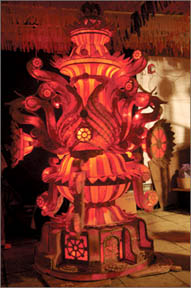
The all important Vesak Koodu |
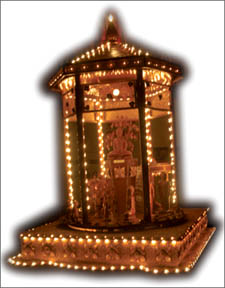
Vesak attractions in Colombo |
My very best memory of Vesak, apart from the visit to the Temple, the
sight of so many oil lamps, the soothing smell of heaps of offered
flowers, and the heady fragrance of hundreds of burning joss sticks, is
the smell of freshly made 'paan piti paappa' [flour paste], multi
coloured 'sav karadasi', freshly cut bamboo sticks, new 'nool bola' and
a the pungent smell of a burning 'boomithel laampuwa'.
Yes, we had no electricity those days - certainly not in the villages
- and it was under a 'boomithel laampuwa' or a petromax lamp [if one was
lucky to have one] that all this 'sarasili' activity was done.
That is, in a way a 'pre-Vesak' memory. Actual Vesak day, or rather
Vesak week memories are many. The first among them that still lights a
million lights in my mind, are the Vesak pandals - Vesak Thoran. In fact
we still call the Armour Street junction down Maradana, the 'Thorana
Handiya' because of the memory of the resplendent pandal that was
erected there every Vesak. Not many outstations boasted of a magnificent
pandal, but Colombo was famous for them.
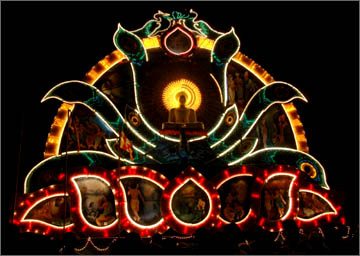 |
|
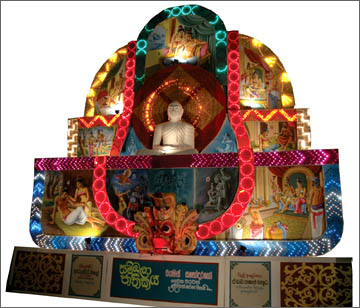
A pandal in Ambalangoda |
There was the Armour Street Thorana, the Borella [C.O.C.] Thorana,
The Pettah [Fish Mudalalais'] Thorana and one more at Dehiwala. Money
was put aside on a daily basis for the erecting of these pandals and set
aside carefully. There may have been public contributions too, as Vesak
drew near. But most pandal-makers were so particular about their own
pandals, that they guarded it jealously as a top secret.
From the age of about seven or eight, upto the age of about fifteen
or sixteen, I used to come to Colombo with my elder brothers, by train
to see the pandals and other Vesak attractions in the city of Colombo.
Often, a simple display in some home front or a lit garden attracted
my attention even more than the pandals. It could have been a 'Sal Uyana'
{The birth of Prince Siddhartha], an 'Abhinishkramana' [The
Renunciation] the Sathara Pera Nimithi [the four signals] or the 'Kiripidu
Daanaya'by the Princess Sujatha. Such displays though not as flashy and
resplendent as the pandals, gave me a deep and abiding sense of Vesak -
a soul cleansing sense.
Sometimes, the maker or makers of such displays, sat in a corner of
the house front or the garden to enjoy the enjoyment of his creation by
others.
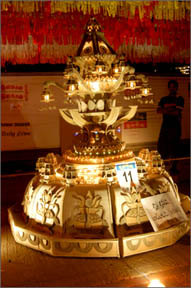 While the pandals blared out all kinds of details about the contents
of the pandal, it's creators, contributors etc., these quiet
contributions of genuine artistry made no such fuss, except perhaps the
subdued playing of some appropriate songs or music in the background.
When we marvelled at some of these creations, the householders would
often invite us in, ask us to sit down and offer some sweet drink and
very shyly introduce the young man or young girl responsible for its
creation. While the pandals blared out all kinds of details about the contents
of the pandal, it's creators, contributors etc., these quiet
contributions of genuine artistry made no such fuss, except perhaps the
subdued playing of some appropriate songs or music in the background.
When we marvelled at some of these creations, the householders would
often invite us in, ask us to sit down and offer some sweet drink and
very shyly introduce the young man or young girl responsible for its
creation.
One of the most breath-taking displays I have ever witnessed in
Colombo was the 'Neranjana Ganga Tharanaya' [The leap over the river
Neranjana] by Prince Siddhartha.
This spectacle came on display for a number of years at Dehiwala,
over the then Dehiwala canal - a little away from the bridge. There was
an element of surprise in this act. We who stood on the bridge to watch
this marvellous spectacle, never knew what time the show would come on.
But it certainly did at least four or five times a night - sometimes
even more.
The display was signalled by a low beat of drums and the sound of a
horse trotting and then galloping. The Prince - a neatly painted and
attired cut-out - on the horse Kanthaka, with friend and companion
Channa seated gingerly behind him, would appear approaching from the
left side of the canal, make a breathtakingly slow leap over the river
[by now it is not a mere canal, but truly a Neranjana river to the
spoectator] to the other side and gallop away. No fuss. No
announcements.
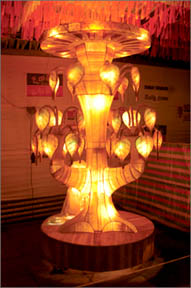 Just the event. It was so secretive and dignified, to my knowledge,
no one dared to go down the slope of the bridge to either find out or
congratulate the creator of this magnificent spectacle. I still dont
know who the creator or creators were. Perhaps no one knows - except the
men who ran the 'dara maduwa' nearby ! Just the event. It was so secretive and dignified, to my knowledge,
no one dared to go down the slope of the bridge to either find out or
congratulate the creator of this magnificent spectacle. I still dont
know who the creator or creators were. Perhaps no one knows - except the
men who ran the 'dara maduwa' nearby !
Another very famous attraction during my teen-age days, was once
again at Dehiwala - at Wally's Studio, to be exact. The owner of Wally's
studio - perhaps together with his friends, staged a play on a built up
stage in front of the Studio.
What was enacted almost every year, was a Jataka story, written by
someone very competent to do so. What was very special about this show
was its 'voicing' cast. The voices belonged to very famous radio
artistes of the day, such as Nethelie and Wallie Nanayakkara, Agnes
Sirisena, Chitra Wakista, Wijeratne Warakagoda, Samuel Rodrigo,
Ratnvalie Kekunawala, Gemunu Wijesuriya and a host of other famous men
and women.
The actors and actresses only 'mimed' the dialogue and songs and the
voices from behind somewhere, simply let go over the loud speakers. The
curious part is that thousands of people from far and near flocked to
Wally's Studio, Dehiwala not so much to 'see' the play but to 'hear' it
in the voices of their beloved artistes. !
Of course there were odd little moments when the mikes failed and the
actors and actresses simply mimed their dialogue - sans voice ! But
things would be put to right pretty soon and the show would continue.
I believe this system still prevails where pandals are displayed, not
only in Colombo, but even in the outstations. I believe some of those
radio [and now, TV too] artistes still lend their voices to these Vesak
plays that go with the bigger pandals.
Vesak, like all other things is hugely 'commercialised' today.
It's a changing world. |
